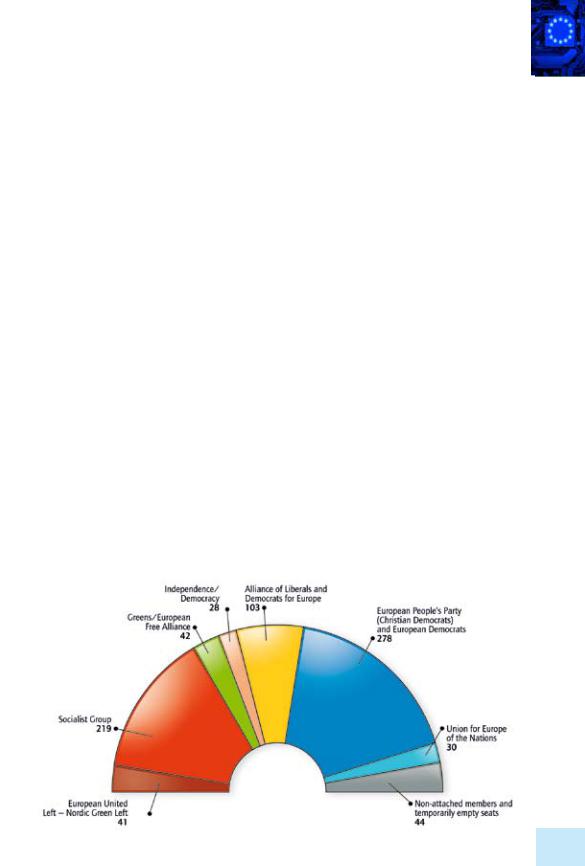
01_EU_overview
.pdf
Number of seats in the European Parliament per country 2007–09
Austria |
18 |
Belgium |
24 |
Bulgaria |
18 |
Cyprus |
|
Czech Republic |
24 |
Denmark |
4 |
Estonia |
|
Finland |
4 |
France |
8 |
Germany |
99 |
Greece |
24 |
Hungary |
24 |
Ireland |
|
Italy |
8 |
Latvia |
9 |
Lithuania |
|
Luxembourg |
|
Malta |
|
Netherlands |
27 |
Poland |
4 |
Portugal |
24 |
Romania |
|
Slovakia |
4 |
Slovenia |
|
Spain |
4 |
Sweden |
9 |
United Kingdom |
8 |
Total |
785 |
The European Parliament normally holds its plenary sessions in Strasbourg and any additional sessions in Brussels. It has 20 committees which do the preparatory work for plenary sessions, and a number of political groups that usually meet in Brussels. The General Secretariat is based in Luxembourg and Brussels.
The Parliament takes part in the legislative work of the EU at three levels:
•Under the ‘cooperation’ procedure, introduced by the Single European Act in 1987, the European Parliament can give its opinion on draft directives and regulations proposed by the European Commission, which is asked to amend its proposals to take account of Parliament’s position.
•Since 1987, there has also been the ‘assent’ procedure, under which the European Parliament must give its assent to international agreements negotiated by the Commission and to any proposed enlargement of the European Union.
•The 1992 Treaty of Maastricht introduced the ‘co-decision’ procedure, which puts the Parliament on an equal footing with the Council when legislating on a whole series of important issues including the free movement of workers, the internal market, education, research, the environment, trans-
The political groups in the European Parliament
Total : 785
Situation in October 2006
Europe in 12 lessons
19

European networks, health, culture, consumer protection, etc. The European Parliament has the power to throw out proposed legislation in these fields if an absolute majority of members of Parliament vote against the Council’s ‘common position’. The Treaty has made provision for a conciliation procedure.
The European Parliament also shares, with the Council, equal responsibility for adopting the EU budget. The Parliament can reject the proposed budget, and it has already done so on several occasions. When this happens, the entire budget procedure has to be re-started. The European Commission proposes the draft budget, which is then debated by the Council and the European Parliament. Parliament has made full use of its budgetary powers to influence EU policymaking.
Last but not least, the European Parliament exercises democratic supervision over the Union. It has the power to dismiss the Commission by adopting a motion of censure. This requires a two-thirds majority. It also supervises the day-to-day management of EU policies by putting oral and written questions to the Commission and the Council. Finally, the President of the European Council reports to the Parliament on the decisions taken by the Council.
c. The European Commission
The Commission is the third part of the institutional triangle that manages and runs the European Union. Its members are appointed for a five-year term by agreement between the member states, subject to approval by the European Parliament. The Commission is answerable to the Parliament, and the entire Commission has to resign if the Parliament passes a motion of censure against it.
Since 2004, the Commission has been made up of one Commissioner from each member state.
The Commission enjoys a substantial degree of independence in exercising its powers. Its job is to uphold the common interest,
which means that it must not take instructions from any national EU government. As ‘Guardian of the Treaties’, it has to ensure that the regulations and directives adopted by the Council and Parliament are being implemented in the member states. If they are not, the Commission can take the offending party to the Court of Justice to oblige it to comply with EU law.
As the EU’s executive arm, the Commission implements the decisions taken by the Council in areas such as the common agricultural policy. It has wide powers to manage the EU’s common policies, such as research and technology, overseas aid, regional development, etc. It also manages the budget for these policies.
The Commission is assisted by a civil service made up of 36 directorates-general (DGs) and services, which are mainly based in Brussels and Luxembourg.
II. Other institutions and bodies
a. The Court of Justice
The Court of Justice of the European Communities, located in Luxembourg, is made up of one judge from each EU country, assisted by eight advocates-general. They are appointed by joint agreement of the governments of the member states for a renewable term of six years. Their independence is guaranteed. The Court’s role is to ensure that EU law is complied with, and that the Treaties are correctly interpreted and applied.
b. The Court of Auditors
The Court of Auditors in Luxembourg was established in 1975. It has one member from each EU country, appointed for a term of six years by agreement between the member states following consultation of the European Parliament. It checks that all the European Union’s revenue has been received and all its expenditure incurred in a lawful and regular manner and that the EU budget has been managed soundly.
20

© Marcy Maloy/Photodisc Red/Getty Images
The Court of Justice makes sure EU law is respected; it has for example acted to ensure that mothers are treated fairly when they go back to work.
c. The European Economic and Social Committee
When taking decisions in a number of policy areas, the Council and Commission consult the European Economic and Social Committee (EESC). Its members represent the various economic and social interest groups that collectively make up ‘organised civil society’, and are appointed by the Council for a four-year term.
d. The Committee of the Regions
The Committee of the Regions (CoR) was established under the Treaty on European Union and consists of representatives of regional and local government proposed by the member states and appointed by the Council for a four-year term. Under the Treaty, the Council and Commission must consult the CoR on matters of relevance to the regions, and it may also issue opinions on its own initiative.
e. The European Investment Bank
The European Investment Bank (EIB), based in Luxembourg, provides loans and guarantees to help the EU’s less developed regions and to help make businesses more competitive.
f.The European Central Bank
The |
European |
Central Bank |
(ECB), based |
in |
Frankfurt, |
is responsible |
for manag- |
ing the euro and the EU’s monetary policy (see Chapter 7 ‘Economic and monetary union (EMU) and the euro’).
Europe in 12 lessons
21

5. What does the EU do?

• The European Union acts in a wide range of policy areas — economic, |
|
|
social, regulatory and financial — where its action is beneficial to the |
lessons |
|
member states. These include: |
||
|
||
• solidarity policies (also known as cohesion policies) |
12 |
|
in regional, agricultural and social affairs; |
||
|
in |
|
• innovation policies, which bring state-of-the-art technologies |
Europe |
|
and development (R&D) and energy. |
||
to fields such as environmental protection, research |
|
|
• The Union funds these policies through an annual budget of more |
|
|
than €120 billion, which is largely paid for by the member states. |
|
|
It represents a small proportion of the EU’s collective wealth |
|
|
(a maximum of 1.24 % of the combined gross national income of all |
|
|
member states). |
|
I. Solidarity policies
The main purpose of the solidarity policies is to support the completion of the single market (see Chapter 6, ‘The single market’), and to correct any imbalances by means of structural measures to help regions lagging behind or industrial sectors encountering difficulties. The need for solidarity between EU countries and between regions became even more acute following the recent entry of 12 newcomers with incomes well below the EU average. The EU must also play its part in helping to restructure sectors of the economy which have been badly affected by fast-growing international competition.
a. Regional aid
The EU’s regional policy is based on transfers of funds from rich to poor countries. The money is used to boost development in regions lagging behind, to rejuvenate industrial regions in decline, to help young people and the long-term unemployed find work, to modernise farming and to help lessfavoured rural areas.
The funds earmarked for regional activities in the 2007–13 budget are targeted at three objectives.
• Convergence. The aim here is to help the least-developed countries and regions
catch up more quickly with the EU average by improving conditions for growth and employment. This is done by investing in physical and human capital, innovation, the knowledge society, adaptation to change, the environment and administrative efficiency.
•Regional competitiveness and employment. The objective is to increase the competitiveness, employment levels and attractiveness of regions other than the least-developed ones. The way to make this happen is to anticipate economic and social changes and promote innovation, entrepreneurship, environmental protection, accessibility, adaptability and the development of inclusive job markets.
•European territorial cooperation. The aim of this new objective is to increase crossborder, transnational and interregional cooperation. It aims to promote joint solutions to problems that are shared by neighbouring authorities in sectors such as urban, rural and coastal development, the cultivation of economic relations, and networking between small and medium-sized enterprises (SMEs).
These objectives will be financed by specific funds, which will top up or stimulate investment by the private sector and by national and regional government. These funds are
23

known as the Structural Funds and the Cohesion Fund:
•The European Regional Development Fund (ERDF) is the first Structural Fund and provides funding to strengthen economic, social and territorial cohesion by reducing differences between regions and supporting the structural development and adjustment of regional economies, including the redevelopment of declining industrial regions.
•The European Social Fund (ESF), the second Structural Fund, provides funding for vocational training and job-creation initiatives.
•In addition to the Structural Funds, there is a Cohesion Fund, which is used to finance transport infrastructure and environmental projects in EU countries whose GDP per capita is lower than 90% of the EU average.
b. The common agricultural policy (CAP)
The aims of the CAP, as set out in the original Treaty of Rome from 1957, have largely been achieved: a fair standard of living has been ensured for the farming community; markets have been stabilised; supplies reach consumers at reasonable prices; farming infrastructure has been modernised. Other principles adopted over the course of time have also worked well. Consumers enjoy security of supply and the prices of agricultural products are kept stable, protected from fluctuations on the world market. The European Agricultural Guidance and Guarantee Fund (EAGGF) is the name of the budget for the CAP.
However, the CAP has been a victim of its own success. Production grew far faster than consumption, placing a heavy burden on the EU budget. In order to resolve this problem, agriculture policy had to be redefined. This reform is beginning to show results. Production has been curbed. Farmers are being encouraged to use sustainable farming practices that safeguard the environment, preserve the countryside and contribute to improving food quality and safety.
© Chris Windsor/Photodisc Red/Getty Images
Producing the food that you eat: quality is as important as quantity.
The new role of the farming community is to ensure a certain amount of economic activity in every rural area and to protect the diversity of Europe’s countryside. This diversity and the recognition of a ‘rural way of life’
— people living in harmony with the land — are an important part of Europe’s identity.
The European Union wants the World Trade Organisation (WTO) to put more emphasis on food quality, the precautionary principle and animal welfare. The European Union has also begun reforming its fisheries policy. The aim here is to reduce the overcapacity in fishing fleets, to preserve fish stocks and to provide financial assistance to allow fishing communities to develop other economic activities.
c. The social dimension
The aim of the EU’s social policy is to correct the most glaring inequalities in European society. The European Social Fund (ESF) was established in 1961 to promote job creation and help workers move from one type of work and/or one geographical area to another.
Financial aid is not the only way in which the EU seeks to improve social conditions
24

in Europe. Aid alone could never solve all the problems caused by economic recession or by regional under-development. The dynamic effects of growth must, above all, encourage social progress. This goes hand in hand with legislation that guarantees a solid set of minimum rights. Some of these rights are enshrined in the Treaties, e.g. the right of women and men to equal pay for equal work. Others are set out in directives concerning the protection of workers (health and safety at work) and essential safety standards.
In 1991, the Maastricht European Council adopted the Community Charter of Basic Social Rights, setting out the rights that all workers in the EU should enjoy: free movement; fair pay; improved working conditions; social protection; the right to form associations and to undertake collective bargaining; the right to vocational training; equal treatment of women and men; worker information, consultation and participation; health protection and safety at the workplace; protection for children, the elderly and the disabled. At Amsterdam in June 1997, this Charter became an integral part of the Treaty and is now applicable in all the member states.
II. Innovation policies
The European Union’s activities impact on the day-to-day life of its citizens by addressing the real challenges facing society: environmental protection, health, technological innovation, energy, etc.
a. The environment and sustainable development
The cornerstone of EU environmental activity is an action programme entitled ‘Environment 2010: our future, our choice‘. This covers the period from 2001 to 2010 and emphasises the need to:
•mitigate and slow down climate change and global warming;
•protect natural habitats and wild fauna and flora;
•deal with problems linked to environment and health;
•preserve natural resources and manage waste efficiently.
Throughout the period covered by this programme and the five programmes preceding it, and in more than 30 years of setting standards, the EU has put in place a comprehensive system of environmental protection.
The problems being tackled are extremely varied: noise, waste, the protection of natural habitats, exhaust gases, chemicals, industrial accidents, the cleanliness of bathing water and the creation of a European information and assistance network for emergencies, which would take action in the event of environmental disasters such as oil spills or forest fires.
More recently, concerns about the health effects of pollution have been examined in an environment and health action plan for the 2004–10 period. This plan establishes the link between health, the environment and research policy.
European regulation provides the same level of protection throughout the EU, but is flexible enough to take account of local circumstances. It is also constantly being updated. For example, it has been decided to rework the legislation concerning chemicals and replace earlier rules, which were developed on a piecemeal basis, with a single system for the registration, evaluation and authorisation of chemicals (REACH).
This system is based on a central database to be managed by a new European Chemicals Agency, located in Helsinki. The aim is to avoid contamination of the air, water, soil or buildings, to preserve biodiversity and to improve the health and safety of EU citizens while at the same time maintaining the competitiveness of European industry.
Europe in 12 lessons
25

b. Technological innovation
The founders of the European Union rightly saw that Europe’s future prosperity would depend on its ability to remain a world leader in technology. They saw the advantages to be gained from joint European research.
© Ross/DigitalAndersen ImagesVision/Getty
Research fuels economic growth.
So, in 1958, alongside the EEC, they established Euratom — the European Atomic Energy Community. Its aim was for EU countries together to exploit nuclear energy for peaceful purposes. As part of this, the Joint Research Centre (JRC) was created consisting of nine institutes at four locations: Ispra (Italy), Karlsruhe (Germany), Petten (the Netherlands) and Geel (Belgium).
However, as innovation gathered pace, European research had to diversify, bringing together as wide a variety of scientists and research workers as possible. The EU had to find new ways of funding their work and new industrial applications for their discoveries.
Joint research at EU level is designed to complement national research programmes. It focuses on projects that bring together a number of laboratories in several EU countries. It also supports fundamental research in fields such as controlled thermonuclear
fusion (a potentially inexhaustible source of energy for the 21st century). Moreover, it encourages research and technological development in key industries such as electronics and computers, which face stiff competition from outside Europe.
The main vehicle for funding EU research is a series of framework programmes. The seventh research and technological development framework programme covers the 2007–13 period. The biggest share of the €50 billion plus budget will go on areas like health, food and agriculture, information and communications technology, nanosciences, energy, the environment, transport, security and space and socioeconomic sciences. Additional programmes will promote ideas, people and capacities, via research work at the frontiers of knowledge, support for researchers and their career development and international cooperation.
c. Energy
Fossil fuels — oil, natural gas and coal — account for 80% of energy consumption in the EU. A large and growing proportion of these fossil fuels are imported from outside the EU. At present, 50% of gas and oil is imported, and this dependence could grow to 70% by 2030. The EU will thus be more vulnerable to cuts in supply or price hikes caused by international crises. Another reason to reduce its consumption of fossil fuels is to reverse the process of global warming.
Various steps will have to be taken in future, such as saving energy by using it more intelligently, developing alternative energy sources (particularly renewable energy sources in Europe), and increasing international cooperation. Energy consumption could fall by one fifth by 2020 if consumers changed their behaviour and if technologies that improve energy efficiency were fully used.
26

Europe in 12 lessons
© Targa/Van Parys Media
Harnessing the planet’s natural sources of energy is one way of combating climate change.
III. Paying for Europe: the EU budget
To fund its policies, the European Union has an annual budget of more than €120 billion. This budget is financed by what is called the EU’s ‘own resources’, which cannot exceed an amount equivalent to 1.24% of the total gross national income of all the member states.
These resources are mainly drawn from:
•customs duties on products imported from outside the EU, including farm levies;
•a percentage of the value-added tax applied to goods and services throughout the EU;
•contributions from the member states in line with their respective wealth.
Each annual budget is part of a sevenyear budget cycle known as the ‘financial perspective’. The financial perspectives are drawn up by the European Commission and require unanimous approval from the member states and negotiation and agreement with the European Parliament. Under the 2007–13 financial perspective, the total budget for this period is €864.4 billion.
27

6. The single market
